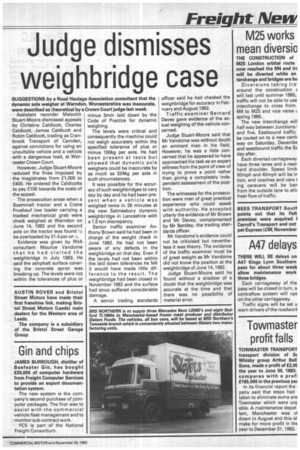Judge dismisses weighbridge case
Page 17

If you've noticed an error in this article please click here to report it so we can fix it.
SUGGESTIONS by a Road Haulage Association consultant that the dynamic axle weigher at Warndon, Worcestershire was inaccurate, were described as Theoretical by a Crown Court judge last week.
Assistant recorder Malcolm Stuart-Moore dismissed appeals by Christine Caldicott, Charles Caldicott, James Caldicott and Robin Caldicott, trading as Cranbrook Transport of Camden, against convictions for using an unsuitable vehicle and a vehicle with a dangerous load, at Worcester Crown Court.
However, Judge Stuart-Moore reduced the fines imposed by the magistrates from £1,000 to £400. He ordered the Caldicotts to pay £100 towards the costs of the appeal.
The prosecution arose when a Scammell tractor and a Crane Fruehauf low loader carrying a tracked mechanical grab were check weighed at Warndon on June 14, 1982 and the second axle on the tractor was found 4.;• be overloaded by 21.4 per ce.•:,.
Evidence was given by RHA consultant Maurice Vandome that he had visited the weighbridge in July 1983. He said the ashphalt surface covering the concrete apron was breaking up. The levels were not within the tolerances of plus or minus 3mm laid down by the Code of Practice for dynamic weighing.
The levels were critical and consequently the machine could not weigh accurately within the specified tolerance of plus or minus 150kg per axle. He had been present at tests but showed that dynamic axle weighers could be inaccurate by as much as 324kg per axle in such circumstances.
It was possible for the accuracy of such weighbridges to vary day by day and he had been present when a vehicle was weighed twice in 28 minutes at the new Salmesbury dynamic weighbridge in Lancashire with a 1.5 ton discrepancy.
Senior traffic examiner Anthony Brown said he had been in charge of the weight check in June 1982. He had not been aware of any defects in the weighbridge on that day. Even if the levels had not been within the laid down tolerances he felt it would have made little difference to the result. The weighbridge had been closed in November 1982 and the surface had since suffered considerable damage.
A senior trading standards officer said he had checked the weighbridge for accuracy in February and August 1982, Traffic examiner Bernard Davey gave evidence of the actual weighing of the vehicle concerned.
Judge Stuart-Moore said that Mr Vandome was without doubt an eminent man in his field. However, he was a little concerned that he appeared to have approached his task as an expert witness from the point of view of trying to prove a point rather than giving a completely independent assessment of the position.
The witnesses for the prosecution were men of great practical experience who could speak with authority. He accepted utterly the evidence of Mr Brown and Mr Davey, complemented by Mr Bentley, the trading standards officer.
Mr Vandome's evidence could not be criticised but nevertheless it was theory. The evidence of the traffic examiner must be of great weight as Mr Vendome did not know the position at the weighbridge of June 14, 1982.
Judge Stuart-Moore said he found without a shadow of a doubt that the weighbridge was accurate at the time and that there was no possibility of material error.




























































































